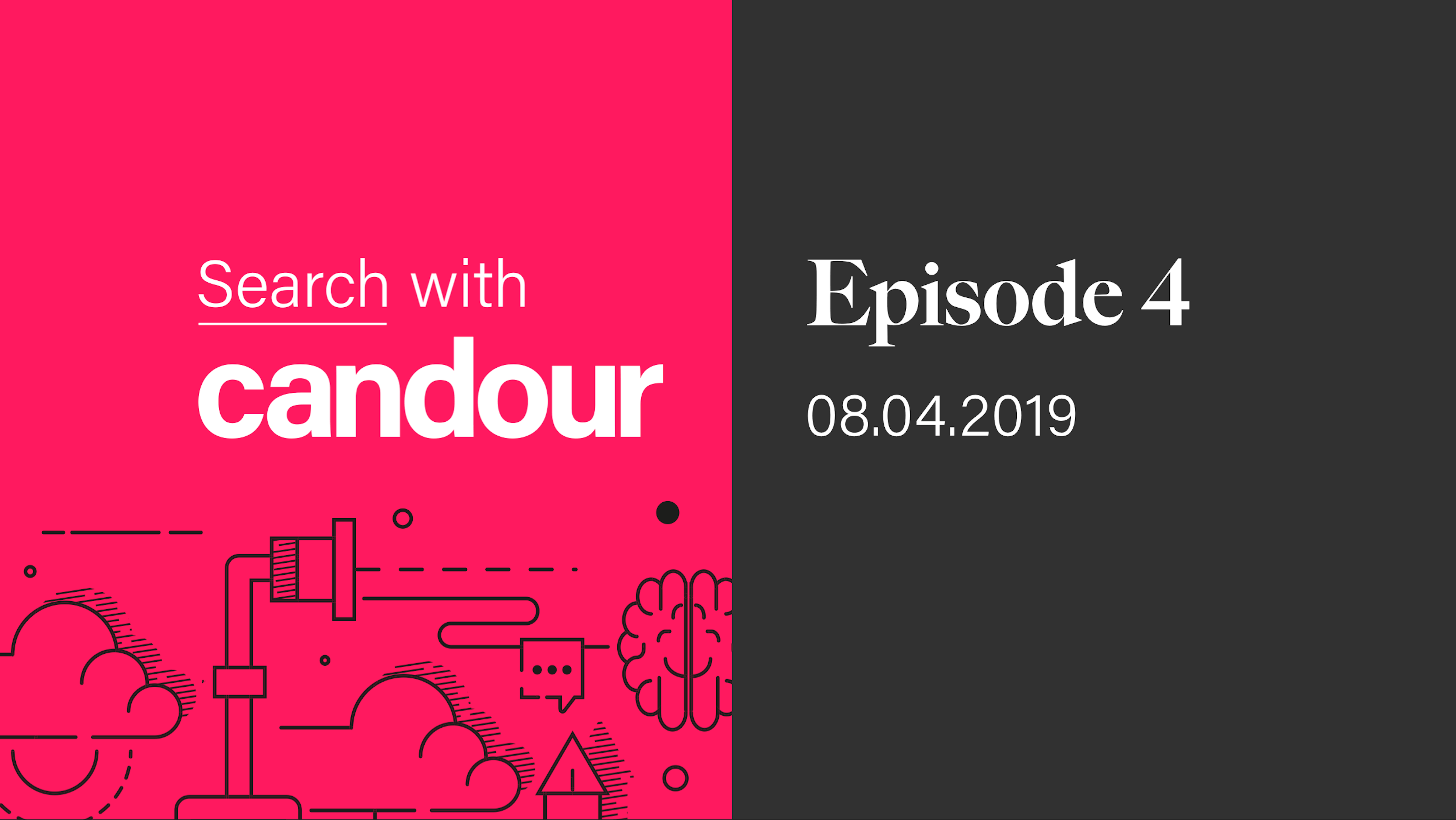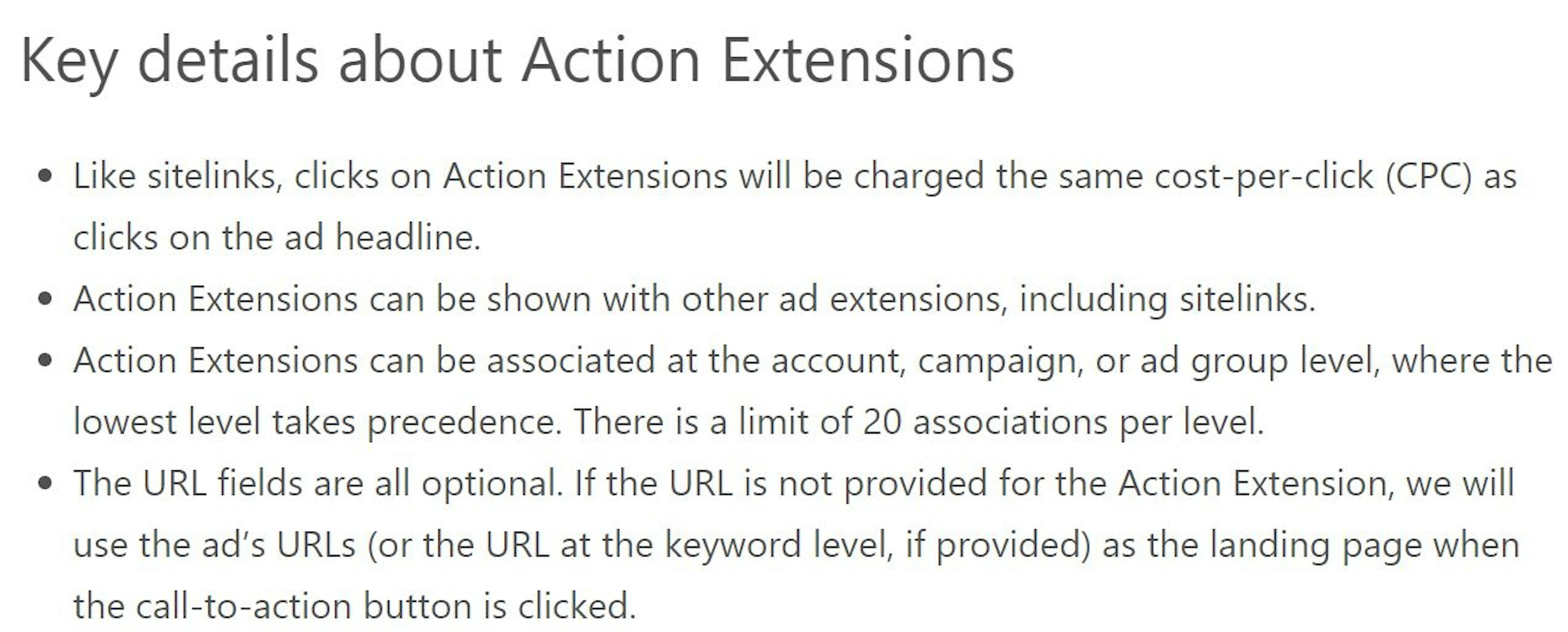08.04.2019
19 min listen
With Mark Williams-Cook & Rob Lewis
Season 1 Episode 4
Episode 4: Sub-site links, custom intent audiences and action extensions

Google's new mobile site links, sunsetting on custom intent audiences and Bing's new Action Extensions bringing 20% better click-through rates.
Play this episode
01
What's in this episode?
Mark Williams-Cook and Rob Lewis will be discussing:
Sub-site links in Google Google appears to be testing a new category of 'sub' site links on mobile. Triggered on brand ads, Google offers searchers the opportunity to navigate directly to products from a vertical accordion.
Google replacing audience keywords with custom intent audiences Rob will explain the different between audience keywords, custom intent audiences and what it means for advertisers on Google Ads.
Bing's Action Extensions Bing has dropped a big new feature that they claim enhances advertiser's click through rates by an average of 20%! We'll find out more about it and how to use it.
02
Transcript
MC: Welcome to Episode 4 of the Search with Candour podcast recorded on Friday the 5th of April 2019. My name is Mark Williams Cook and I'm once again joined by Mr. Rob Lewis who will be adding some context and insight to our PPC news.
RL: Hello!
MC: As usual we've got about 15 minutes of SEO and PPC news that'll hopefully make your lives a bit easier! Topics for today on the SEO side of the fence, something possibly new from Google which is sub-site links that have been showing on mobile. PPC news, we've got news from both Google and Bing. Google are sunsetting audience keywords this month and replacing with custom intent audiences. Rob will take you through exactly what those things are if you don't know and what it practically means to you. Bing - some exciting news, have dropped a big new feature we're going to talk about that at the end of the show. According to them it's been improving advertisers’ click-through rate by 20%!
MC: Okay so starting with the SEO news this is actually one I picked up from LinkedIn which is strange because LinkedIn isn't normally the place where I get my SEO news from. Jack Cooper who is the digital manager of Anderton's music company posted on LinkedIn saying:
Play this episode
He included a screenshot that I will post in the show notes as well so you can see it to yourself, but what it essentially shows is a search result for guitar pedals for Anderson's music company and as usual you've got in blue site links below the main search results snippet. Additionally you have a kind of arrow that you can tap on which is going to you an extra kind of sub set of site-links. These site-links are actually linking directly to products. Now this isn't something I'd seen before, I don’t know if you've seen it before Rob?
RL: I haven't no.
MC: So I think looking at the other comments from other SEO people on LinkedIn, it wasn't something anybody else was particularly familiar with so this does look new. I emailed Jack to see if he had any more information and just to ask him how he came across this and he very kindly replied saying: “We've been doing a lot of work on our e-commerce category structures to ensure users can better navigate where they need to get to. During testing the impact of this on desktop and mobile, I noticed the mobile search offering a secondary drop-down option. After investigation this was showing a selection of director product links from the parent category when using a brand + category query, such as Anderson's guitar pedals” which is the result he took a screenshot of. He goes on to say “I didn't expect to see product links here, it looks as though Google are testing and/or introducing yet another reason for you to have your site structure in order.
It also means you should ensure your product pages are in top order, as with most site links there will probably be a lack of control. Anderton's is a relatively large e-commerce site so not only do sub-site links give users an indication of your most popular categories, but products within them too. I've entered the same search multiple times and I'm getting the same sub-site links each time. It won't be long until this is used in some form of competitor analysis, we may also see a decline in first level category clicks being replaced by sub-categories and now even products.”
So I think that's that's really interesting because it demonstrates Google kind of doubling down (if you like) on intent. Jack notes in his email back to me that he's only managing to trigger these results when he's doing a brand search and a product, and I think when you're doing brand and product searches you're giving a better indication of your intent to Google that you want to look at a specific site maybe and these extra results are taking up more space in the search engine results page. So they're pushing down other competitors that would otherwise be ranking for these terms, so Google is really saying ‘okay I'm pretty sure you want to look at this site so I'm going to give you the option from the search result page to go anywhere within this category.’
It's worth noting and is something we keep seeming to mention, where we did a whole talk on it from SearchNorwich in the last episode and we mentioned schema in the episode before that but it is worth mentioning I noticed the Anderton site is using product schema on their pages. I would guess it's likely that's also what's giving Google the confidence to do this, meaning it can understand this is definitely a product page and from as Jack says from the site structure it understands what category it's under and I'd be interested to hear from anyone if they've seen an example of these direct product site links or sub-site links - I don't know what we're going to call them in the industry yet. I'm interested to hear if anyone has seen an example of these on a site that's not using schema. So again the takeaway here is if you're not using schema on your site, especially if you're an e-commerce site, it's definitely time to have a look at that.
So in the PPC news, for those running Google Ads accounts you may have got an email in the last week or so saying “important audience keywords in Google Ads is being upgraded to custom intent audiences.” So this email is triggered if you're running any Google Ads accounts that is using audience keyword ad groups. Google's telling us they're going to be automatically upgraded to ‘custom intent audiences’ this month in April 2019.
Google’s email outlines what's changing, it says: “custom intent audiences are replacing audience keywords to provide better performance, more scalability, simplified audience management, and optional auto-created audience recommendations. With custom intent audiences you can define and reach your ideal audience through an auto-created audience suggestion or by selecting your own keywords, URLs, and apps. So I think it's a good time for you to jump in Rob, can you run through what audience keywords and custom intent audiences are firstly for those maybe that don't know?
RL: Okay so first off, custom intent audiences have been around for a while now in the new Google Ads interface, but to explain what audience keywords are (as this is what they're removing). So when setting up a Display Network campaign in Google Ads, one targeting method is to control the type of content that your ads are appearing on which you can do using keywords, so if you added the keyword ‘Australian tours’ for example then your advert would be eligible to show on any Google Display Network content that matches that keyword - so that type of targeting is called content keyword targeting. But taking it a step further you can expand that targeting so that rather than simply showing on content that matches your keyword, you can also reach users who had exhibited an interest or who had been searching for those keywords. So this effectively expands your reach so that you can target relevance interested people and show them adverts regardless of rich content they're viewing. So using the ‘Australian tours’ example that I mentioned, someone searching for that term on Google might be reading a news article about something entirely different but the advert could still show to this user.
MC: Okay, I mean what do you think about this change because as you know how I'm always skeptical whenever Google upgrade a product change or product. We've discussed before about the keyword targeting changes; I'm always skeptical they're doing it for for their own reasons and maybe it's not always what’s best for advertisers in every case, whether they have made some good changes. What are your thoughts on on this change?
RL: Well it's worth stating actually you can still carry out keyword audience targeting in Google Ads, once this change is rolled over you can still do what you were doing before you can still share ads on content based on the keywords and you can still carry our audience targeting via keywords. Google was just migrating the old keyword audiences tool to its new intent audience tools. So I mean for those who don't know about intent audiences, it's basically a way of targeting users by their interests or by what they've been actively researching to purchase at that time. So for example if you want to target users who are actively seeking to purchase your products you'd create what's called a ‘custom intent audience list’, and within this list you can add a tightly themed group of keywords that relate to your products or services.
Google recommends a minimum of 14 keywords but I try to add more if I can. But basically over time you create a list of relevant things you'd like to target - relevant products, relevant services, and you can do this by adding a mix of keywords as well as websites as well. So the theory of this in itself is quite powerful because you could as an example you could create an intent list that comprises a list of competitor websites, which would allow you to show adverts to users who have been actively researching or visiting your competitor's website. So it's a lot more powerful than the old keyword audience targeting technique that the old interface used to rely on, but the example that I just gave is what's called a ‘custom intent audience’ which is targeting users based on their current search and behavioral intent. There's actually another type of custom audience called a ‘custom affinity audience’ which allows you to target users by their general interests. So let's just say you've got a product or service that nobody actively searches for, maybe they don't know that it exists but which might appeal perfectly to users who have an interest in certain things. You could create what's called a ‘custom affinity list’ that might comprise a list of keywords that describe their interests, or you can input a list of websites that they're likely to visit.
Google also provides some auto-created audience lists as well which is worth just being careful before you target them because it basically creates an automatic generated list based on traffic that you've received in the past - but it might not actually be relevant to your to your Google display strategy so just keep an eye on what it's suggesting that you target. But ultimately both of those things I've mentioned - the custom intent and the custom affinity list. This is what Google is migrating the old keyword audience targeting to.
MC: So the the email says it's just alerting people who are still currently using keyword audience targeting. I assume if you're not using them you don't have to do anything. So what would you have to do if you are using the keyword audience targeting, is Google just going to automatically upgrade? Do I need to do it, would you need to do anything?
RL: Well actually the email says that you automatically upgrade them but if you read a bit further down onto the email it says that there's an automatic tool that you can use to convert them over to custom intent. Which I've not used so my personal preference would just be to start from scratch and to create a custom intent list based on your requirements for your business or for your client.
MC: Okay so probably better off just doing it, if you're going to have to change to use it and learn a bit more about it and actually do it properly from the ground up rather than relying on kind of automation.
RL: Yeah absolutely.
MC: It sounds like good general advice for dealing with Google Ads.
Finally Bing Ads, I'm a fan of Bing Ads - are you Rob?
RL: It's an important channel, I think managing day-to-day basis can be a bit soul-destroying but it does its job and it works!
MC: So I'm still a fan of Bing at it because I think it's easy to overlook them but Bing still does kind a decent amount of monthly searches. Google obviously is always telling us about their 22,000 phrase searches per second but Bing still got a decent amount. The cost per click is somewhat merciful sometimes compared to Google Ads right?
RL: Absolutely yeah.
MC: For the listeners, if you are running Bing Ads they've launched quite a major new feature. On April the 3rd on the official Bing Ads blog they posted something titled ‘Drive customers to immediate action with Action Extensions’ and they're go on to say:

MC: 20%! That's pretty significant isn't it?
RL: Yeah I'd say so!
MC: And they go on to give a few key details about action extensions:

MC: So I assume that's maybe if you want a direct booking action to go to a different URL perhaps to the main ad. So. what do you think about that? Are you a bit more excited about Bing Ads?
RL: I have to say I think it's the first Bing Ads update that has got me somewhat excited, I really like the sound of this. I've had a bit of a play around a bit earlier today actually and I really like that there's 70 call-to-actions predefined to choose from, although moving forward I think it would be really good if they enable a custom call-to-action a bit like what Google offers on YouTube for example and on Gmail.
MC: So you can only select from a template?
RL: Yeah at the moment, absolutely. But I was looking through some of them and some of them made me think there's some interesting ones. Like I saw ‘vote now’, so that would be an interesting choice for political campaigns - might be worth keeping an eye on that on Bing Ads in the future. ‘Bet now’ obviously for gambling sites, they'll make use of that. Another one that I thought could be potentially useful is the ‘visit store’ call-to-action so it'd be really useful as maybe an interesting metric for businesses to potentially measure measure footfall, so they can see how many people clicked on the ‘visit store’ button may have then gone and actually visited the premises.
MC: I guess you could put that straight to directions or something as well.
RL: Yeah, yeah. I mean I think I think it's a really interesting update that they're adding because Google has a lot of different extensions available but they don't have anything quite like this. I mean you can you can customize call-to-actions on YouTube, display, and Gmail ads, and to a lesser extent there are message extensions that you can use on Google search but nothing like what Bing Ads just introduced so I'm really looking forward to seeing what impact it has actually and I wonder if Google will follow suit. Iff they can see that it's been a successful rollout.
MC: That would make an interesting change, Google copying Bing for once.
RL: Yeah, yeah!
MC: So you say you've you've tried these, are they simple enough to set up?
RL: Oh really easy, you just navigate over to the ad extensions tab, select action extensions and create a new one.
MC: Okay so if you're running a paid search campaign in Bing ads there's seemingly a very easy way to likely get 20% improvement in your click-through rate. It's worth noting if you are running Google Ads and not Bing Ads, Bing Ads does have the functionality to simply import your search ads campaigns from your Google account. So it essentially means you can set up a Bing Ads account with pretty much no time investment, so you don’t have to go through the same process as you did with Google so it can be a nice quick easy thing for you to test.
That's everything for this week, the next episode of Search with Candour will be going live on Monday the 13th of April just after the Brighton SEO conference. I hope we’ll see some of you there. My name is Mark Williams Cook and I’ve been with Rob Lewis and I hope you listen again!

